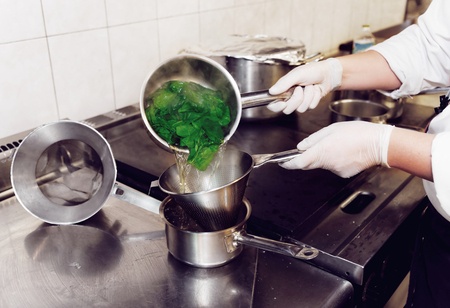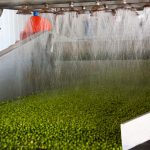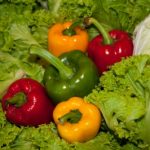
Blanching is an important aspect of cooking, especially when vegetables are to be used for further processing or storage. It is a pretreatment essential to minimising undesirable changes in produce as a result of enzymatic reactions (Grandison, 2012).
At the chef’s level, it involves plunging vegetables into boiling water to scald them for about a minute, possibly two and then immediately placing them into iced water as in an ice bath. Running under a very cold tap of water also serves this purpose by removing heat from the process and halting any further changes. The process of cooling is called shocking or refreshing
The idea is to denature the enzymes which cause loss of colour and texture so that they retain their crunch and vibrant colours. It sounds a simple process and to all intents and purposes it is. The science behind the process is one of the most intensely studied and has been investigated for centuries making it one of the best known processes.
Objective Of Blanching
The process of blanching inactivates enzymes responsible for discoloration, softening and off-flavours, and reduces microbial counts which can spoil produce on storage. It also helps clean the outer surfaces of the produce. However, an optimal process is necessary to maintain colour, texture, flavour and the nutritional quality of products.
Blanching Methods
The National Center for Home Food Preservation offers a range of guidelines on home based blanching using hot water, steam and microwaving followed by cooling.
- Hot Water
- Steam
- Microwaving
Pretreatment Before Canning
Canning has the advantage of offering a long shelf life to any fruit and vegetable, indeed many years is possible. Unfortunately, without blanching, canned vegetables tend to lose texture becoming soft, stringy, mushy or start sloughing and breaking up when handled.
Pretreatments such as blanching coupled with other techniques often minimise these effects and can even improve firmness. Classic examples of the blanching process with green beans prior to canning prove the value of the technique (Van Buren et al., 1960).
One example where the flavour is improved by blanching is in the removal of tannins. For example, African Yam Beans (Sphenostylis stenocarpa) are first dehulled and then blanched for an extended period in hot water for 40 minutes at 100 °C (Aminigo et al., 2005). Dehulling is also improved by this process.
Potato strips for frying are blanched before cooking in oil at a lower temperature than needed because the inner parts of the vegetable are slightly precooked. This means less frying is required and allows for the external surface of the potato to crisp more effectively. It’s a practice used extensively by the chef Heston Blumenthal.
Enzymes Denatured By Blanching
A number of enzymes are denatured and deactivated by blanching. It is one of the main reasons why people do this because enzymes, even ones which are partially active will affect the quality of food on long-term storage. The enzymes affected are mainly lipoxygenases, polyphenol oxidase (PPO) and peroxidase (POD) are denatured.
Enzymes which are activated and improve firmness in vegetables and fruit include pectin methyl esterase (PME). The firming effect is due to activation of pectin methyl esterase (PME) at a blanching temperature of 140-167°F which makes large numbers of free carboxyl groups available on the pectin molecules. A low-methoxyl pectin is generated which can then be cross-linked by calcium ions that are present in the tissue (Van Buren et al., 1962).
Improved firmness is reported with canned vegetables such as cauliflower (Hoogzand et al., 1961), tomatoes (Hsu et al., 1965) and potatoes (Bartolome and Hoff, 1972). Green beans, whether frozen or canned also exhibit improved firmness (Van Buren et al., 1962).
Issues Of Blanching
Nutrient losses are inevitable with any heat processing and blanching is no different in this regard. Vitamin C (ascorbic acid) is highly soluble in water and will always leach out of the vegetable or fruit and into the process water. It is also susceptible to breaking down (degradation) during heating (De Corcuera et al., 2004). In fact, this aspect of its behaviour makes it a useful marker for the degree of blanching and general heat processing. Vitamin C loss during low-temperature blanching of garden peas was highly marked and took the usual root of ascorbic acid converting to DHA (dehydroascorbic acid) which then leached away.
For those of you wanting to know about blanching as a process in more detail, I would read the article on smoothie preparation which is hosted on the web-site, easyhealthysmoothie. This site looks at how to make delicious smoothies to suit all tastes. Worth a visit !
References
Aminigo, E.R. & Metzger, L.E. (2005) Pretreatment of African yam bean (Sphenostylis stenocarpa): effect of soaking and blanching on the quality of African yam bean seed. Plant Foods Hum Nutr. 60(4) (Dec.) pp. 165-71.
Bartolome. L.G. and Hoff, J.E. (1972) Firming of potatoes: biochemical effects of preheating. J. Ag. Food Chem. 20: pp. 266.
De Corcuera, J.I.R., Cavalieri, R.P., Powers, J.R. (2004) Blanching of foods. In: Encyclopedia of Agricultural, Food, and Biological Engineering. New York: Marcel Dekker Inc. pp 1–5
Hoogzand, C. and Doesburg. J. (1961) Effect of blanching on texture and pectin of canned cauliflower. Food Technol. 15: pp. 160.
Hsu. C., Deshpande, S. and Desrosier, N. (1965) Role of pectin methyl esterase in firmness of canned tomatoes. J. Food Sci. 30 pp. 583.
Grandison, A.S. (2012) Chapter 1. Postharvest handling and preparation of foods for processing. In: Brennan JG, Grandison A.S., editors. Food processing Handbook. 2nd ed. Wiley-VCH Verlag GmbH & Co. KGaA. Weinheim, Germany. pp 1–30
National Center for Home Food Preservation. (Article). Accessed 07/03/2017
Steinbuch. E. (1976) Improvement of texture of frozen vegetables by stepwise blanching treatments. J. Food Technol. 11 pp. 313.
Van Buren, J.P.. Moyer, J.C., Wilson, D.E.. Robinson. W.B. and Hand, D.B. (1960) Influence of blanching conditions on sloughing, splitting and firmness of canned snapbeans. Food Technol. 14: pp. 233.
Van Buren, J.P., Moyer, J.C. and Robinson. W.B. (1962) Pectin methyl esterase in snap beans. J. Food Sci. 27 pp. 291



Leave a Reply